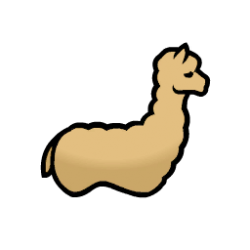Difference between revisions of "Alpaca"
(Outdated or incorrect numbers - automating and expanding.) |
|||
| Line 88: | Line 88: | ||
=== Wool === | === Wool === | ||
| − | An alpaca produces the same amount of wool (at the same intervals) as a [[sheep]], but | + | An alpaca produces the same amount of wool (at the same intervals) as a [[sheep]], but sheep consume {{%|1-({{Q|Sheep|Real Hunger Rate}}/{{Q|Alpaca|Real Hunger Rate}}) round 2}} less nutrition. Compared to [[sheep wool]], [[alpaca wool]] offers {{Temperature|{{#expr:{{Q|Alpaca wool|Insulation - Cold Factor}} - {{Q|Sheep wool|Insulation - Cold Factor}}}}||delta}} better insulation against Cold and {{Temperature|{{#expr:{{Q|Alpaca wool|Insulation - Heat Factor}} - {{Q|Sheep wool|Insulation - Heat Factor}}}}||delta}} against Heat, and is more {{%|({{Q|Alpaca wool|Market Value Base}}/{{Q|Sheep wool|Market Value Base}}) -1 round 2}} more valuable. Thus, the alpaca wool is superior to sheep wool. If the goal is to make bulk wool, regardless of stats, then sheep are more efficient when grazing is insufficient to feed the herds and equally efficient the rest of the time. If the sole purpose is to make money, then alpacas are better than sheep. In addition, alpaca are pack animals. |
| − | Alpacas are superior to other wooly animals ([[bison]], [[muffalo]], and [[megasloth]]s) in terms of wool per nutrition consumed. Bison and muffalo would be better for wool per ''colonist work'', though the amount of work to harvest wool isn't terribly large in practice. | + | Alpacas are superior to other wooly animals ([[bison]], [[muffalo]], and [[megasloth]]s) in terms of wool per nutrition consumed. Bison and muffalo would be better for wool per ''colonist work'', though the amount of work to harvest wool isn't terribly large in practice. The insulation and market value of alpaca wool is also superior to that of both [[muffalo wool]] and [[bison wool]]. Megasloth wool offers superior cold insulation and protection, however due to the wildness and intelligence of megasloths, they are not directly comparable to other wooly animals. See [[Megasloth#Wool|their page]] for further analysis. |
== Training == | == Training == | ||
Revision as of 02:28, 29 March 2023
Alpaca
A medium-sized ungulate closely related to the llama, the alpaca is usually raised for its remarkably soft and insulating wool. Alpacas have also been used as pack animals since they hauled cargo on the rugged mountain trails of ancient South America.
Base Stats
- Type
- Animal
- Flammability
- 70%
Pawn Stats
- Move Speed
- 4.1 c/s
- Health Scale
- 100% HP
- Body Size
- 1
- Mass - Baby
- 12 kg
- Mass - Juvenile
- 30 kg
- Mass - Adult
- 60 kg
- Pack Capacity
- 35 kg
- Carrying Capacity
- 75 kg
- Filth Rate
- 16
- Hunger Rate
- 0.44 Nutrition/Day
- Diet
- herbivorous
- Life Expectancy
- 15 years
- Manhunter Chance
- 0%
- Manhunter Chance (Taming)
- 0%
- Trainable Intelligence
- None
- Wildness
- 25%
- Minimum Handling Skill
- 1
- Roam Interval
- 3 days
- Mate Interval
- 12 hours
- Maturity Age
- 0.333 years (20 days)
- Juvenile Age
- 0.2 years (12 days)
- Comfortable Temp Range
- -20 °C – 45 °C (-4 °F – 113 °F)
Production
- Meat Yield
- 140
 alpaca meat
alpaca meat - Leather Yield
- 40
 camelhide
camelhide - Wool Amount
- 45
 alpaca wool
alpaca wool - Shearing Interval
- 10 days
- Gestation Period
- 6.66 days
- Offspring Per Birth
- 1
Melee Combat
- Attack 1
- Front left leg
7.3 dmg (Blunt)
11 % AP
2 second cooldown - Attack 2
- Front left leg
7.3 dmg (Poke)
11 % AP
2 second cooldown - Attack 3
- Front right leg
7.3 dmg (Blunt)
11 % AP
2 second cooldown - Attack 4
- Front right leg
7.3 dmg (Poke)
11 % AP
2 second cooldown - Attack 5
- Teeth
8 dmg (Bite)
12 % AP
2 second cooldown
0.7 chance factor - Attack 6
- Head
7 dmg (Blunt)
10 % AP
2 second cooldown
0.2 chance factor - Average DPS
- 2.28
- tradeTags
- AnimalFarm, AnimalCommon
Alpacas are easily tameable herbivores that provide wool and act as pack animals.
Obtaining
Alpacas can be found in temperate forests, temperate swamps, tropical rainforests, and tropical swamps. They can either be tamed by a handler or self-tame in a random event.
Alpacas can be bought and sold in other faction bases and from bulk goods traders. Alpacas purchased from traders will be already tamed.
Summary
Alpacas are pen animals. Once tamed, pen animals cannot and do not need to be trained any further. But if left outside of a pen or caravan hitching spot, pen animals will eventually roam outside your colony. Making a caravan is not required to tie animals to a caravan hitching spot.
Alpacas can be sheared for ![]() 45 alpaca wool (
45 alpaca wool (![]() 171) every 10 days.
171) every 10 days.
Alpacas are also pack animals, and will carry up to 35 kg of weight in a caravan. They cannot be ridden.
Analysis
Pack animal
Alpacas are the smallest pack animal, carrying the least weight and consuming the least food. But, as early-game pack animals, alpacas are strictly inferior to donkeys.
- Donkeys are easier to tame, carry more weight, and can be ridden for up to 130% caravan speed. Even when you standardize for nutrition consumption, donkeys still carry more weight.
- Horses are slightly harder to tame than alpacas, but horses are even faster (160% caravan speed) and carry even more weight.
Alpacas can be useful for early-game caravans, in absence of the other options. In a tropical biome, donkeys and horses are not available. The other native pack animal there is the elephant, which is much harder to tame.
And, unlike donkeys and horses, alpacas produce wool.
Wool
An alpaca produces the same amount of wool (at the same intervals) as a sheep, but sheep consume 18% less nutrition. Compared to sheep wool, alpaca wool offers 4 °C (7.2 °F) better insulation against Cold and 6 °C (10.8 °F) against Heat, and is more 41% more valuable. Thus, the alpaca wool is superior to sheep wool. If the goal is to make bulk wool, regardless of stats, then sheep are more efficient when grazing is insufficient to feed the herds and equally efficient the rest of the time. If the sole purpose is to make money, then alpacas are better than sheep. In addition, alpaca are pack animals.
Alpacas are superior to other wooly animals (bison, muffalo, and megasloths) in terms of wool per nutrition consumed. Bison and muffalo would be better for wool per colonist work, though the amount of work to harvest wool isn't terribly large in practice. The insulation and market value of alpaca wool is also superior to that of both muffalo wool and bison wool. Megasloth wool offers superior cold insulation and protection, however due to the wildness and intelligence of megasloths, they are not directly comparable to other wooly animals. See their page for further analysis.
Training
This animal can be trained as follows:
| Guard: | |
|---|---|
| Attack: | |
| Rescue: | |
| Haul: | |
*As of version 1.1.2610, all animals can be tamed. The percentage of likelihood of success depends on factors such as the Animals Wildness Percentage, Pawn Handling Skill, and others. More information can be found on the animals page.
Health
Gallery
Version history
- 0.12.906 - Can now be shorn for wool
- Beta 19/1.0 - move speed 3.8 -> 3.2, leg damage 7 -> 6
- Version 1.3 - Animal Overhaul







